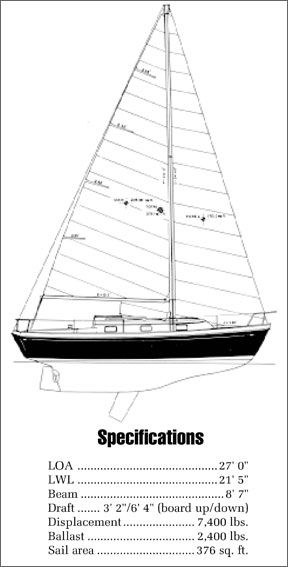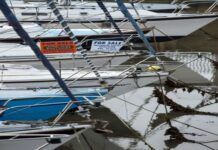Any article on the Tartan 27 has to approach being a historical treatise since this is a truly venerable craft by any standard, ancient or modern. The origins of Tartan Marine rest in Douglass & MacLeod Plastics, and in Charles Britton.

In the spring of 1971, Britton (who had been building the Tartan line at Douglass & MacLeod formed Tartan Marine, a boatbuilding firm that has a long-standing reputation for producing quality boats that remain in production far longer than the average for stock fiberglass craft. The Tartans 27, 30, 34, and 37 have been available for more years than most boatbuilders with competing products have been in business. In short, Tartan has had a successful sales record that has been the envy of the industry.
A Close Look at the Boat
The Tartan 27 went into production in 1961 with fiberglass boatbuilding in its toddler stage; production ceased in 1980, after 19 years interrupted only by a fire in l972 that resulted in no 27s being built that year. The greatest number of 27s built in one year is 85; the year was 1964. In all, 712 Tartan 27s were built, including a dozen boats under license in California. Remarkably few significant changes were made to the boat until near the end of the long production run, after hull #650. Those that are noteworthy are as follows:
• 1966 External keel encapsulated and ballast increased by 350 pounds
• 1973 Deck redesigned with a longer cockpit and a bridgedeck plus some changes to the interior decor.
• 1977 Sheerline raised 4″ and deck again redesigned, eliminating the rather boxy looking doghouse; interior given a more traditional layout. About 65 boats were built to this configuration before production ended in 1979.
The Tartan 27 was designed by Sparkman & Stephens as a small and relatively narrow edition of the then popular hull form—a combination of keel and centerboard, moderately heavy displacement, and short overhangs topped with a low aspect masthead rig. In all, the 27 is what aficionados regard as a superb example of a small yacht of traditional proportions.
At the same time the boat is well constructed and finished and has at least adequate performance for a centerboard boat of her size, hull shape, and weight (average PHRF base rating, 235), sailing equal to such full keel counterparts as the Cape Dory 27 and the Triton. The 27 has a reputation as a well balanced boat capable of sailing with the helm unattended in moderate conditions, an advantage afforded by the centerboard, short rig, and narrow beam. Like other narrow boats she tends be quick to heel initially but stiffens at an angle of 20 degrees or so. She should be sailed “on her feet,” however, for optimum windward performance. Overpowered, she carries a heavy weather helm.
The 27 had two standard engine installations: until about 1975 the Atomic 4 was offered, and thereafter both the Atomic 4 and the Farymann one cylinder 12 hp diesel. About 85% of the 27s were fitted with the Atomic 4. Owners report the 27 comfortably overpowered with the Atomic 4, a bit underpowered with the Farymann. As with any long keel boat with the propeller in an aperture, backing down is an adventure.
The masthead rig of the 27 uses a large mainsail and modest sized foretriangle. Performance calls for overlapping headsails (as big as 176% LP for racing).
A small number of 27s, for what we assume was quaintness rather than any practical reason, were rigged as yawls with handkerchief-sized mizzens on a mast stepped into the lazarette.
The original interior layout had a dinette, midships galley, cockpit-opening icebox, quarterberth, and small head—a cramped interior by “modern” standards.
Later 27s had a more traditional layout with settee berths, an aft galley, no quarterberth, a chart table, and a larger athwartships head. The result is still cramped but with better use of space, especially with elimination of the dinette.
From all reports, the basic construction of the Tartan 27 has proven superb with few exceptions. The outward turned hull-to-deck flange is not one PS recommends, being more subject to difficult-to-repair damage than the common inward flange. Breakage of the teak rubrail is a problem frequently mentioned by owners. At the same time the outward flange does help keep the deck and cockpit drier; complaints about leaking through this joint are notable for their absence.
Apparently many 27s were built with wood supports under the mast step. Several owners report eventual rotting of this wood with the subsequent collapse of the step, the result of water leaking around the mast partner. Similarly, several cite water damage to other wood structures such as bulkheads in way of the mast. Solution: stop the leaks, provide drainage and replace the wood at the first sign of deterioration.
Otherwise the most often mentioned problem is delamination of the balsa-cored deck, especially in the way of the chainplates that, improperly bedded or not checked periodically, let water seep in. This is a serious problem, hard to recify, but by no means unusual for older fiberglass boats.

Tartan 27 owners, at least the ones we have heard from, are a resourceful group. Many mention improvements they have made to their boats and amenties they have fitted. Add to this the remarkably useful Tartan 27 Handbook that the Chesapeake Bay class association put together and prospective owners have ample suggestions to work with.
What to Look For
We have already mentioned a couple of crucial items to check prior to purchasing a 27: the mast step and the possibility of deck delamination. Others that owners report are as follows:
• During the production history a variety of fuel tanks found their way into boats. Some have developed leaks; since the majority of 27s use gasoline, a leaking fuel tank is serious.
• The Atomic 4 engine for seeming eons has been as reliable a piece of marine machinery as has been devised by the hand of man. Engines 20+ years old are still performing in exemplary fashion. But they need care and attention; check for loss of compression, oil and water leaks, electrical corrosion, and cracked mounts in particular. The Farymann diesel is reliable but parts are expensive and vibration can loosen mounts, couplings, hose connections, etc.
• The centerboard pennant can wear through the tubing from the turning block to the trunk, both weakening the cable and eventually causing a leak.
• Most of the centerboards in the 27 are fiberglass encapsulated steel plate (the first dozen boats had bronze). In time the board at the pivot can wear away, dropping the centerboard and letting it hang solely on its pennant (which, if weak, can break and lose the board). Check carefully for such wear.
• The rudder post has no bearing between it and the tube through which it runs. Eventually the wear between the post and tube produces sloppiness and noise. The best answer we have seen is to install an external bearing or collar at the upper end of the tube.
• In the words of the Tartan 27 Handbook, “Perhaps the weakest point on the Tartan 27 is the tiller head fitting.” Both wear and cracking occur, neither particularly difficult to detect or remedy, but best to be forewarned.
Few boats the size of the Tartan 27 better lend themselves to substantial refurbishing. Owners detail complete restoration of interiors, repowering, the addition of amenities such as gas stoves, pressure water systems and the like, refinishing decks and topsides with polyurethane (many were built with colored gelcoat topsides that have become badly chalked), and a passel of other such improvements. Components such as fiberglass hatches, rudders and centerboards are still available from the builder.
Conclusions
In many ways and for a variety of reasons a boat like the Tartan 27 is typical of the best offerings on the used boat market. The boat is fundamentally sound and reasonably available in a range of prices. Its inherent quality makes maintenance and upgrading practical. Strong owner associations and builder support are an invaluable resource rare among boats of this vintage. Besides, the 27 is a centerboarder that sails well, looks handsome, and stays together.
For this appeal the price is apt to be high, although boats in basically sound but cosmetically disasterous condition are available at prices that make refurbishing practical. The same can be said for relatively few smaller boats more than 15 years old. In our opinion the Tartan 27 should be a most attractive consideration for the buyer looking for quality on a modest budget, if willing to put effort into increasing the comfort, performance, and appearance of his boat rather than investing in it up front.
At the same time the 27 has its limitations: a cramped interior, “age spots” such as scruffy gelcoat, possible deck delamination, centerboard wear, gas engines getting on in years, and, in an age of sailing performance, so-so speed.
Virtues and flaws balanced, however, the Tartan 27 strikes us as having most of what we would look for in an older small cruising boat from the standpoint of ruggedness, appearance, function, and equity. They may seem costly but we suspect that even Tartan 27s built in the 1960s will be around far longer than a lot of cheaper boats 10 or 15 years younger. And we like the last version of the 27, the one with the higher topsides, lower cabin profile, and, to our mind, more comfortable interior layout. These are classic used boats of their type.

































